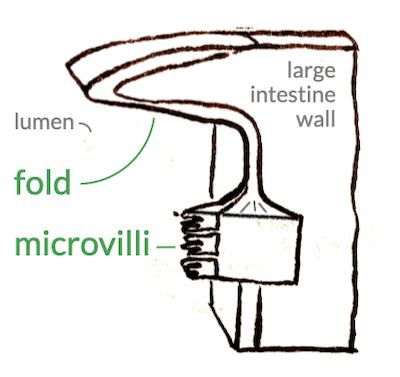What's the surface area of the digestive tract? A visual synthesis

ˬ˯vᐯ˅ˇ⌣ᘁ᥎ᨆ⏝ࡍ⩗ᨆ⌣˘ ˬ ᥎ᐯᨆ⌣ᘁ⩗ᨆࡍ˯
This post is part of my project about the Digestive System.
What is the surface area of the entire human digestive system? What is the area of the small intestine?
From lips to anus, our digestive tract is about 32 m2 (38 yards2). And about 94% of this area corresponds to the small intestine alone!
Estimating the actual area of the gastrointestinal tract is difficult, because it is basically a tube of muscles that does not have a fixed shape. That said, many researchers have tried to estimate our gut area over the years.
Here, I selected and summarized the most recent and robust estimate, from Helander et Fändriks (2014)1.
Have a good read!
Table of content
Entire digestive tract: 32 m2 (38 yards2)
From lips to anus, our gastrointestinal tract is a tube of 32 m2 of inner surface area (38 yards2).
The mouth is about 0.02 m2 (0.31 in2)2, the esophagus 0.02 m2 (0.31 in2)1, the stomach 0.05 m2 (0.54 in2)1, the small intestine 30 m2 (36 yards2)1, and the large intestine 2 m2 (2.4 yards2)1.

Before the publication of this paper, we thought this area was about 300 m2 (360 yards2), like a tennis court, or a very very large apartment. But, in 2014, after Helander et Fändriks tried to reassess this area, for each section of the digestive tract, they concluded that 32 m2 (38 yards2) was more accurate1.
Hence, our digestive tract area is more like “half a badminton court”, they say, or, like a small apartment! However, this value is just an average, for a healthy adult human being.
This area corresponds to the exchange surface area between the content of the digestive tract, called the lumen, and the tract lining called the mucosa.
The small intestine is ~94% of our gut area!
The surface area of the small intestine is folded at three levels.
These folds significantly increase the exchange surface area between the lumen and the mucosa, allowing the small intestine to absorb nutrients efficiently.
The small intestine is covered with circular folds perpendicular to the flux of the food.
These folds are covered by small finger-like structures called villi.
Villi are, in turn, covered by cells, called epithelial cells, whose membrane is also folded into microvilli.
With a length of 2.9 m (3.2 yards), and such a fractal folding, the small intestine exchange surface area is about 30 m2 (36 yards2)!
The large intestine is ~6% of our gut area
The surface area of the large intestine is folded at two levels.
The folds in the large intestine are smaller and less numerous than in the small intestine.
The mucosa is not covered by villi, but only microvilli on epithelial cells.
With a shorter length of about 1.9 m (2 yards) and this less complex folding, the large intestine exchange surface area is about 2 m2 (2.4 yards2), hence much smaller than that of the small intestine.
But, how did these scientists estimate this surface area?
The method they used to estimate the surface area
To estimate the surface area of the digestive tract, the researchers considered it as a cylinder. Overall, the inner surface area of the digestive tract is hence obtained by multiplying the length of this cylinder by its circumference.
At first, this seems quite a simple geometrical calculation, but there are two big difficulties.
First, the length and width of this cylinder are hard to measure. Because, in addition to being hidden inside our belly, our digestive tract is a tube of muscles whose shape constantly changes. Hence the researchers needed to choose reasonable averages for length and width. I discussed this in the method section of my article about the length of the digestive tract.
Second, as we have just seen, this cylinder is not smooth, especially in the small and large intestines. Folds, villi, and microvilli increase the actual surface area between the lumen and the membrane of the absorptive cells. Hence, the researchers multiplied the area of a theoretical smooth cylinder by some “enlargement factors”.
In addition, both the length of the digestive tract and the enlargement factors vary a lot between individuals!
Hence, given this high variability, it is not really possible to calculate the exact surface area, but rather “a reasonable baseline estimate of the intestinal mucosal surface area in an adult healthy human being”, as Helander et Fändriks write in their paper1.
Small intestine surface area estimation
For the small intestine, they selected an average length of 2.91 m (~3.2 yards) and an average diameter of 2.5 cm (~1 in). Then, they considered that folds enlarge the actual surface area by 1.57, villi by 6.5, and microvilli by 13.
Thence, the formula:
\[ Area ≈ (2.91 m × π × 0.025 m) × 1.57 × 6.5 × 13 ≈ 30 m^2 \]
Large intestine surface area estimation
For the large intestine, they selected an average length of 1.90 m (~2 yards) and an average diameter of 4.8 cm (~2 in). Then, they considered that the folds in the large intestine don’t significantly enlarge the surface area, and, as we saw, there are no villi in the large intestine. So, the enlargement is only due to microvilli, but as they are shorter than in the small intestine, scientists chose an enlargement factor of 6.5, instead of 13.
Thence, the formula:
\[ Area ≈ (1.90 m × π × 0.048 m) × 6.5 ≈ 1.9 m^2 \]
The large intestine is wider than the small intestine, but it is shorter and smoother. This results in a much smaller internal surface area than the small intestine!
- Previous experiment (16/26) : A sample of 12 delicious Taiwanese food
- Next experiment (18/26):
experiment ongoing… please, come back on Sunday…
Did you enjoy this post?
Great! Then, you may also like this visual summary of the length of the digestive tract, or a zoom on how protein digestion works.

